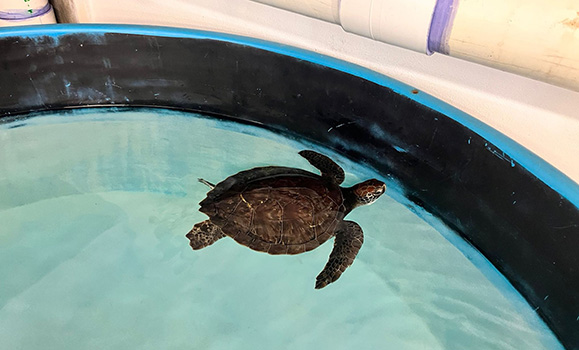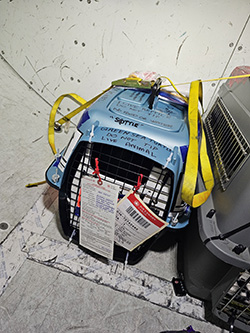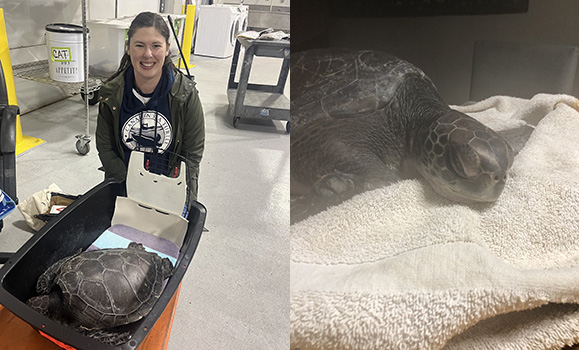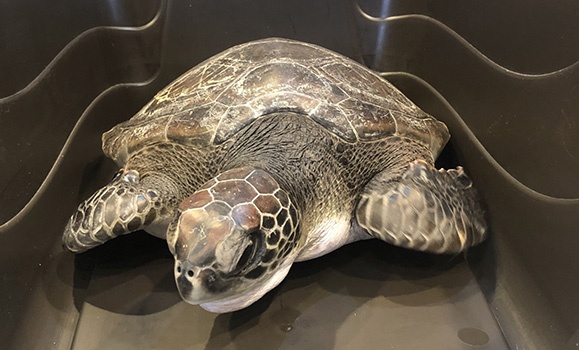An endangered green turtle that drifted into water that was too cold for it is happily swimming in a roomy, warm-water tank in Bermuda after being found hypothermic on a Nova Scotia beach and reared back to health by a team of veterinarians, government officials, a conservation group and a Canadian airline.
Scottie the green sea turtle was flown last Thursday to the Bermuda, Aquarium Museum and Zoo (BAMZ), where she is being rehabilitated by staff before being returned to the wild. Her journey there, though, began a week earlier on the frigid shoreline of Scots Bay — hence the name Scottie — in the Minas Basin.
A couple walking the beach came upon her cold and motionless body, and quickly called marine animal experts who might be able to help. One of those, Dal veterinarian Chris Harvey-Clark, has tended to many turtles who have drifted into cool Canadian waters and quickly turned his basement bathroom into a makeshift turtle sanctuary.
"Welcome to the turtle hospital!" he says in a chronicling Scottie's journey, which involved a few sleepless nights for Dr. Harvey-Clark and veterinarian Dr. Pat Pryor, his wife, who stayed up with Scottie.
"I'm very happy about the outcome and also glad to be catching up on my sleep!"

Scottie swims happily at the Bermuda, Aquarium Museum and Zoo.Â
Nursing Scottie back to health
Dr. Harvey-Clark bought an inflatable green kid's pool, squished it into their tub and filled it with freshwater for Scottie to move around in without hurting herself, as turtles are programmed to swim and can move in violent bursts. They also set up a 68-litre plastic tote with a towel on the base — called the drydock — for Scottie to calm down and rest.
They assessed her and ran blood tests to determine her health status. She was hypothermic, showing some slight voluntary movements, depressed and sluggish, but had a shell that was not damaged from being knocked on rocks. At five kilograms, she also had an abundance of fat that is unusual for turtles that wash ashore and are often emaciated.
The team, including Kathleen Martin of the (CSTN), had to be careful in warming and rehydrating her with freshwater to avoid driving down sodium levels.
"If Scottie was rewarmed too fast it can kill her, so we had to do a controlled rewarming and get her back up to about 21 to 22 degrees, which we did over about 36 hours," Dr. Harvey-Clark says. "She recovered very nicely and got super active, but then became depressed so we knew we needed to start salting the water."
A major effort
As Scottie improved, her caregivers were busy trying to arrange her move to a facility with the resources to care for her — a logistical feat involving various agencies and governments in different countries.
 Because green sea turtles are an endangered species, both export and import permits are required to transport them internationally. That can take 120 days in the United States, which was too long for Scottie to wait and unfortunately ruled out an easy trip to the epicentre of cold-stunned sea turtle rehabilitation, the New England Aquarium.
Because green sea turtles are an endangered species, both export and import permits are required to transport them internationally. That can take 120 days in the United States, which was too long for Scottie to wait and unfortunately ruled out an easy trip to the epicentre of cold-stunned sea turtle rehabilitation, the New England Aquarium.
So, Dalhousie alum and federal sea turtle biologist, Dr. Mike James, worked with his international colleagues to find a space for her at the BAMZ. The CSTN, BAMZ, and Canadian and Bermudian federal officials worked around the clock to secure several permits. The CSTN was also working simultaneously with Air Canada, who partnered on flights and in-transit care for Scottie on her journey.
"Everyone really pulled together -- there was a huge army of people and a very complicated web of communication. We were on the phone half the day sorting it out, while taking care of the turtle, who was banging away all night long!"
With the flights secure, Drs. Harvey Clark and Pryor adapted a small carrier for Scottie by covering the holes with mesh to prevent rodents from getting in during transport.
Above left: Scottie in transit. (Air Canada photo)
A rare survivor
Dr. Harvey-Clark acknowledges that some might wonder why so many people went to such great lengths to save one turtle.
"She is probably five years old and the attrition rate is one in 1,000. So many never make it out of the burrow where they are born and those that do get picked off by birds or when they go to sea," he says.
"So, she's worth much more than that one in 1,000!"
Martin says her group has dealt with nine other cases of stranded turtles in November alone. Scottie is the only one that survived. The fact that more of these species are being found cold-stunned in our waters may be a result of climate change and warming water temperatures, she says.
“The best chance these cold-stunned turtles have for survival is being found as soon as possible after they wash up on the beach. We think this was one of Scottie’s major advantages," says Martin.
"Scottie is only the second turtle in 25 years that survived more than 48 hours, so she’s a really big deal for us. Often you feel like the sea turtle coroner, so it's nice to feel like a sea turtle rehab person!"

Above left, Dal alum Emily Bond met up with Scottie in Toronto to manage all the customs paperwork during a layover at Pearson International Airport.
* If you live in the Maritimes and come across a live or dead sea turtle — about the length of a school ruler and usually black, grey or white — the CSTN advises against putting them back in the water. Please move them well above the tide line and call the group at 1-888-729-4667.

